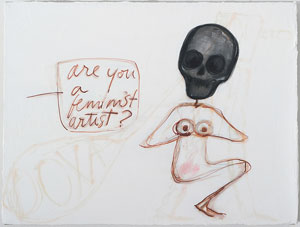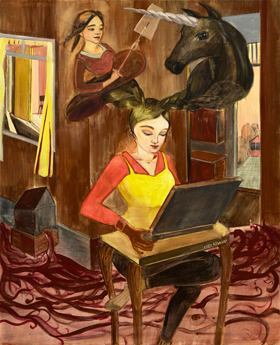Outgrowing the LES
John Haberin New York City
Rosa Loy and Chatham Square
If reopenings after Covid-19 were not themselves a sign of hope, there might yet be another: even as more galleries shut their doors for good, the art scene expands.
No, not quite to Harlem, where Gavin Brown gives up a four-tier space and even more stunning program to join an established dealer in Chelsea. Surely not to Bushwick either, where the hub on Bogart Street has lost its allure along with so much else. Ellen Hackl Fagan and Seth Callander with Odetta even recreated its former Brooklyn space in miniature on 127th Street, where the gallery may soon be losing its lease. Still, the Lower East Side keeps growing, south and west—to the point of outgrowing itself. If the neighborhood seems to have attention deficit disorder, one artist laments just that, even as she boasts of it. The most hyperactive imagination, though, belongs to Rosa Loy. 
Hyperactivity disorder
It was bound to happen, just as in Bushwick or in Dumbo and Williamsburg before it, and I should be the last to minimize the devastation. Galleries bring gentrification, which brings more galleries before forcing them out. It starts gently enough, as the moves push against borders. Downs & Ross and Martos did so, slipping west just across the Bowery. Several more settled in for now way to the north and east, as far as Ulterior at East Houston and Attorney. Prepared to walk more than a mile between them? It will take you to such stalwarts as Bureau, Participant, Chapter NY, Pierogi, and Rachel Uffner—but, I suspect, not everyone is.
No wonder far too many can no longer afford to remain. Kristen Lorello, Meredith Rosen, and now Turn have chosen the Upper East Side, where proximity to collectors was never in doubt. Who knew that was affordable? And two clusters within walking distance of the Lower East Side have become destinations themselves. At first I took them for further neighborhood growth, and I still treat them as slightly annoying detours, but they ask to stand on their own. Nicelle Beauchene, Jane Lombard, and 1969 are joining a dozen downtown and Chelsea refugees just east of Tribeca—and now an alternative centers on Chinatown.
There, too, everyone is a refugee. The first to arrive, Foxy Productions, left a once-stellar block in Chelsea. At its birth on the Lower East Side, Essex Flowers required a trip to the basement of an actual flower shop next to Kossar's Bialys—and then a second flight of stairs back up. That gallery now lies a bit further out between the Manhattan and Brooklyn Bridges, but others are within a block of Chatham Square, at the foot of the Bowery. You may recognize it from the square's white arch, like a pale version of Chinatown in San Francisco. You may hate the cluster for its distance from the subway, and I cannot swear that it will survive. Still, with a large new space for Lyles & King, it is willing to take its chances.
That gallery and Foxy welcomed the fall with group shows, of artists with a discomforting physical edge, like Dan Herschlein and Mira Schor. while Lubov had not yet opened. I understand, though, if you might prefer something more than a grab bag. You might be hoping for the magic of pixie dust or the permanence of fine marble. If so, feel free to make that extra fine, for Tracy Thomason incorporates marble dust, at Marinaro. It can bring texture to monochrome, inviting one up close as hard-edged colors dart this way and that. It can also form lines and curves distinguishable from the background by its thickness alone. Compositions may feel too arbitrary to stand out from so much abstraction today, but it gives a fresh dimension to the play of figure and ground.
Thomason herself may be a bit uncomfortable with the results. She calls the show "White Rabbit," after Alice in Wonderland, and claims a representational side that I doubt is there. Two flights down, Theodore Sefcik carries the fantasies into animations. And their awkward space between high and low tech resounds within a single artist around the corner, at M 23. Connor McNicholas runs to plants, antennas, cables, a close-circuit camera, and goodness knows what else for forms and materials alike, along with ambient music on facing speakers and a CD to take home. If the pandemic has left you uncertain whether to retreat to the country or to splurge on devices for city living, he might consider that the contemporary dilemma in art and life.
Back north of Canal, Martos continued its support of artists with cryptic but creepy devices and damaged human souls, not to mention bodies—first with Kayode Ojo and then two Croatian artists collaborating as Tawruk. At Downs & Ross, Dani Leder does her best to contain the damage, but it will not so easily go away. She calls her show "Sparks Joy," and sparks fly in one work after the other, but joy resides only in her frankness and sense of humor. The text within paintings tries to balance the opposites, of pleasant and unpleasant, while asking that you leave her alone until she has had her meds. Naturally they include treatment for hyperactivity disorder, and these are active works, with thicker white brushwork to single out the human figure and aluminum to add sparks. The gaunt figure could be sexually active or looking for a hiding place, but Leder leaves others with nowhere to hide.
To keep her fantasies
Rosa Loy must work hard to keep her fantasies straight, but then so do her characters. They do, that is, unless they have long since given up trying. One sits at her laptop in a room hardly able to hold them all. No wonder it has so little space for her and her tiny desk. One hand wraps around the monitor rather than the keyboard, assuming the desk even holds one. From her barest hint of a smile, it must be all she can do to watch the wonders unfold without adding more of her own.
Above, another young woman faces off against a unicorn, in what might be playful sparring or just mutual recognition. Unicorns should be white, but this one has the sable coat of a black stallion. It all but invites touching to feel the richness, but its partner wields a spatula instead toward its white horn. Like the woman of Loy's dreams, she has escaped from the kitchen once and for all—much as the heroine of another painting is content to let angels stir the pot, while the best candidates for a meal, chickens, run free. If the angels lack wings, they can still take flight. They might serve earthly women as a lesson.
The writer's study may be cramped, but it has many cunning passages. One leads to a back room with a half-open door as a promise, another to a driveway. A neighbor's house has shrunk to the size of a dollhouse and wandered in, where it spills out a profusion of what might be tendrils or blood. Are these multiple perspectives, as in Cubism? Or are they multiple imaginings, as in Surrealism? Maybe both, but a perspective or an imagining is still the business of a writer.
 It is the business of an artist as well, and you are welcome to ask just who is creating whom. Is the writer a stand-in for Loy or yet another imagining? Is she in charge of the goings-on about her or ignoring them all? She attends to the monitor alone, while the combatants above are tangled in her hair. Is a figure in another work with even wilder hair leading twin girls in a slow dance—and are they even twins? Their dresses do not quite match, no more than their blond and auburn hair, but the piercing yellow of those dresses would carry any fantasy a long way.
It is the business of an artist as well, and you are welcome to ask just who is creating whom. Is the writer a stand-in for Loy or yet another imagining? Is she in charge of the goings-on about her or ignoring them all? She attends to the monitor alone, while the combatants above are tangled in her hair. Is a figure in another work with even wilder hair leading twin girls in a slow dance—and are they even twins? Their dresses do not quite match, no more than their blond and auburn hair, but the piercing yellow of those dresses would carry any fantasy a long way.
Loy provides minimal guidance, whether to the viewer or to them. As the painting of a writer has it, Thoughts Are Free. She does, though, have many acts of creation. A mermaid gives birth in one painting, with a host of others pouring in to meddle or to marvel. Magi or shepherds with the infant Jesus have nothing on them. Loy makes a point of having only women—or so she says, although elves with facial hair assist at a tree planting, and I mistook the curly haired newborn for a boy. If there is such a thing as a "merboy," it may as well be here.
Where gender is a concern, can sex be far behind? No one is exactly sexy, but one woman, on a pedestal like an oversized chess piece, does seem to be sticking cones to her side and chest like way too many pointy breasts. No one is exactly innocent either, for all the air of fairy tales. A woman presents a black goose to a shadowy character indeed, and I hesitate to say what comes next. One last woman takes personal charge of moving day—not with furniture, but with an entire house on her cart and a tree-lined pool in her hands. If her fantasies go wrong, a woman here can always start over.
The German artist has entered her sixties, but these are not leftovers from long-past fancies and Salvador Dalí. She could well be as young as her cast. Art today has many unconstrained narratives, as with Katherine Bradford, Rachel Harrison, and more others than I care to mention—talented, self-indulgent, or both. Loy's unusual choice of casein as a medium allows an overall somberness amid the profusion. Her visible brushwork enhances the realism while leaving "expression" to her stories. Not even that blood red can stain their pleasures.

Tracy Thomason, Theodore Sefcik, and Connor McNicholas ran at their galleries through October 11, 2020, Kayode Ojo at Martos through November 7, Dani Leder at Downs & Ross through December 5, and Rosa Loy at Lyles & King through November 15. Tarwuk ran at Martos through January 9, 2021.




